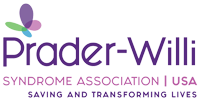By: Cindy Szapacs, M.Ed. BCBA
Before getting into the nuts and bolts of this article, I would like to introduce myself and explain why I am writing this series of articles. I am a mother of two boys, one of whom has Prader-Willi Syndrome. I also am a Board Certified Behavior Analyst. I currently work in the public school system, but over the years I have worked in homes, a private school, and a university. I have served as a direct service provider as well as a consultant and trainer. I was involved in this field long before my son with diagnosed with PWS; however, he has been one of my best teachers. Because of him, I know I am better at my job now than I was 11 years ago. One of the things I have learned is that PWS often throws a wrench in things. This is especially true when talking about typical applied behavior analysis (ABA) interventions, as certain ones must be tweaked or abandoned when PWS enters the picture. Through this series of articles, my goal is to help the reader understand what ABA really is and how it can be used to help those who have PWS.
Imagine this scenario: Your child, who has Prader-Willi Syndrome, is having a birthday party. At the last 10 birthday parties she attended, she did not appear to enjoy the party until after the cake was over. While she is a bubbly, social girl who will talk to anyone about her dogs, she spent the bulk of the party with you, asking about the cake, biting her nails, and tightening the muscles on her face. At 7 of the parties, she also engaged in yelling, crying, and throwing items prior to cake time. Knowing what you do about PWS and how those with the syndrome cannot help but think about food pretty much all of the time, you took this plus the observations from the previous parties into consideration when planning this year. After all, your daughter deserves to have a party she can enjoy.
You hypothesize that she engaged in these problem behaviors because she wanted to have cake; therefore, having the cake first should solve this problem. On party day, once all of the guests have arrived, you announce that cake and singing will happen first. Your daughter asks about the cake a few times in those 15 minutes while people are arriving, but once the cake is brought out, she smiles, her hands remain in her lap, she engages in conversations with others, and she moves on to enjoy the next 2 hours of her party.
For anyone who is familiar with PWS, this situation probably sounds familiar. It probably also is no surprise that this solution worked. But why did it work? In order to answer this question, let’s look at the process that was used to come up with the solution.
1. The mother observed her daughter over multiple opportunities – 10 parties
2. She relied on observable behaviors – asking about food, staying with mom, nail biting, tightening facial muscles, yelling, throwing items, crying
3. She found a trend in when her daughter engaged in the problem behaviors by looking at what occurred immediately before and immediately after the behaviors – the behaviors occurred prior to cake and stopped once cake was served
4. She used these facts to hypothesize why the daughter was engaging in these behaviors – to gain access to cake
5. She created an intervention based on the function of the behavior – access to cake granted first
6. She took medical cause into account – given the PWS brain and how it processes the idea of food, allowing access early rather than teaching her to wait for the cake seemed like a more feasible solution
7. The goal of the intervention was to increase the daughter’s engagement in independent and socially acceptable behaviors
The process described above is an example of how the principles of applied behavior analysis (ABA) can be used in everyday life. For those who have heard of ABA, they often think of it as a highly structured intervention that occurs at specific times. While some ABA interventions require this intensity, these are only a few of many types of interventions that use the principles of ABA. The truth is that ABA is set of principles, not one specific intervention, that relies on scientifically validated interventions to guide implementation. In order to better understand this concept, some common myths about ABA are explained below:
Myth 1: ABA is a single intervention that only occurs in highly structured settings, like a school, clinic or small room in a house.
Truth: ABA is problem-solving approach to changing behavior. All ABA interventions are guided by the same 7 dimensions: generalization (learned behavior occurs in multiple environments, effective (interventions monitored), technological (procedures defined clearly and concisely), applied (socially significant behaviors are targeted), conceptually systematic (interventions based on current literature), analytic (decisions data-based), behavior (observable and measurable behaviors targeted). Using these dimensions, interventions can occur in a variety of settings.
Myth 2: ABA is only effective for preschool and elementary children, especially those with more significant delays.
Truth: ABA is a branch of psychology that is based on the principles of human learning; therefore, these principles can be used to teach people of all ages and abilities. The beauty of ABA is that the interventions are highly individualized, so materials used with and the skills taught to teenagers and adults can be chosen so they are developmentally and age-appropriate. Individuals can be taught to wash dishes, ride a bike, and have a conversation using the principles of ABA.
Myth 3: ABA programs turn children into “little robots.”
Truth: Initially, when ABA intervention was popularized as an effective intervention for people with disabilities, one type of teaching method, discrete trial training, was used. This type of teaching is characterized by the learner responding to large amounts of instructions, in a fast-paced manner. Learners acquire the ability to respond to instructions quickly and effectively. Over the years, it has become clear that a quality ABA program is one the consists of a variety of intervention techniques so learners not only acquire responding skills, but also acquire skills necessary to be a social and independent person. This involves teaching that is implemented both at a table and in the natural environment using “real life” materials. Additionally, instruction is both teacher and student-led and academic, social, independent, work, emotional, and self-help skills can all be taught using ABA technology.
Myth 4: ABA only works for those who have autism.
Truth: The scientific and individualized nature of ABA makes it an appropriate tool for any person, whether they have a known disability or not.
Myth 5: ABA relies on punishment and food rewards to teach students.
Truth: One component of ABA intervention is using consequences to change behavior. Positive reinforcement, presenting something following a behavior in order to increase the likelihood that the person will engage in that behavior again, is always used as the initial consequence strategy. Punishment procedures are only used as a last resort, once all other options have been tried. While the goal of positive reinforcement is to increase a behavior, the goal of a punishment procedure is to decrease behavior. When used, a punishment procedure is implemented alongside a positive reinforcement intervention. Data are collected in order to ensure that the procedure is effective and that the individual is not experiencing any detrimental effects. In terms of what are used as positive reinforcers, the answer is that anything can be used. The main criterion is that the reinforcers are socially acceptable, not harmful to the person, and serve to increase engagement in the target behavior. Reinforcing items are highly individualized and can change frequently. In fact, reinforcers do not have to be physical items. Verbal praise, high-5’s and access to “free time” can all be reinforcers, if they serve to increase engagement in the target behavior.
Myth 6: Any teaching professional can implement ABA programs.
Fact: If a child is participating in a formal ABA program, the program should be supervised by a Board Certified Behavior Analyst (BCBA) on a regular basis. BCBA’s undergo extensive training in the field of ABA. They also are required to pass a board certifying test in order to receive the title of BCBA. In order to keep the title of BCBA, they must complete a specific number of approved continuing education credits and submit them to the Behavior Analysis Certifying Board for approval every 2 years. Unfortunately, only a few states have laws that require a person to have their BCBA in order to deliver behavior analytic services. It also is an option for parents, caregivers and teachers to receive guidance from a BCBA without implementing a structured “program” in their house or classroom.
In short, applied behavior analysis is a problem-solving approach to behavior that does not subscribe to one specific intervention. It is a set of principles that guide intervention to teach learners socially significant behaviors. In the upcoming articles, more information about ABA and the uniqueness that PWS brings to its implementation will be discussed.





 Jennifer Bolander has been serving as a Special Education Specialist for PWSA (USA) since October of 2015. She is a graduate of John Carroll University and lives in Ohio with her husband Brad and daughters Kate (17), and Sophia (13) who was born with PWS.
Jennifer Bolander has been serving as a Special Education Specialist for PWSA (USA) since October of 2015. She is a graduate of John Carroll University and lives in Ohio with her husband Brad and daughters Kate (17), and Sophia (13) who was born with PWS. Perry A. Zirkel has written more than 1,500 publications on various aspects of school law, with an emphasis on legal issues in special education. He writes a regular column for NAESP’s Principal magazine and NASP’s Communiqué newsletter, and he did so previously for Phi Delta Kappan and Teaching Exceptional Children.
Perry A. Zirkel has written more than 1,500 publications on various aspects of school law, with an emphasis on legal issues in special education. He writes a regular column for NAESP’s Principal magazine and NASP’s Communiqué newsletter, and he did so previously for Phi Delta Kappan and Teaching Exceptional Children. Evan has worked with the Prader-Willi Syndrome Association (USA) since 2007 primarily as a Crisis Intervention and Family Support Counselor. Evans works with parents and schools to foster strong collaborative relationships and appropriate educational environments for students with PWS.
Evan has worked with the Prader-Willi Syndrome Association (USA) since 2007 primarily as a Crisis Intervention and Family Support Counselor. Evans works with parents and schools to foster strong collaborative relationships and appropriate educational environments for students with PWS. Dr. Amy McTighe is the PWS Program Manager and Inpatient Teacher at the Center for Prader-Willi Syndrome at the Children’s Institute of Pittsburgh. She graduated from Duquesne University receiving her Bachelor’s and Master’s degree in Education with a focus on elementary education, special education, and language arts.
Dr. Amy McTighe is the PWS Program Manager and Inpatient Teacher at the Center for Prader-Willi Syndrome at the Children’s Institute of Pittsburgh. She graduated from Duquesne University receiving her Bachelor’s and Master’s degree in Education with a focus on elementary education, special education, and language arts. Staci Zimmerman works for Prader-Willi Syndrome Association of Colorado as an Individualized Education Program (IEP) consultant. Staci collaborates with the PWS multi-disciplinary clinic at the Children’s Hospital in Denver supporting families and school districts around the United States with their child’s Individual Educational Plan.
Staci Zimmerman works for Prader-Willi Syndrome Association of Colorado as an Individualized Education Program (IEP) consultant. Staci collaborates with the PWS multi-disciplinary clinic at the Children’s Hospital in Denver supporting families and school districts around the United States with their child’s Individual Educational Plan. Founded in 2001, SDLC is a non-profit legal services organization dedicated to protecting and advancing the legal rights of people with disabilities throughout the South. It partners with the Southern Poverty Law Center, Protection and Advocacy (P&A) programs, Legal Services Corporations (LSC) and disability organizations on major, systemic disability rights issues involving the Individuals with Disabilities Education Act (IDEA), Americans with Disabilities Act (ADA), and the federal Medicaid Act. Recently in November 2014, Jim retired.
Founded in 2001, SDLC is a non-profit legal services organization dedicated to protecting and advancing the legal rights of people with disabilities throughout the South. It partners with the Southern Poverty Law Center, Protection and Advocacy (P&A) programs, Legal Services Corporations (LSC) and disability organizations on major, systemic disability rights issues involving the Individuals with Disabilities Education Act (IDEA), Americans with Disabilities Act (ADA), and the federal Medicaid Act. Recently in November 2014, Jim retired.